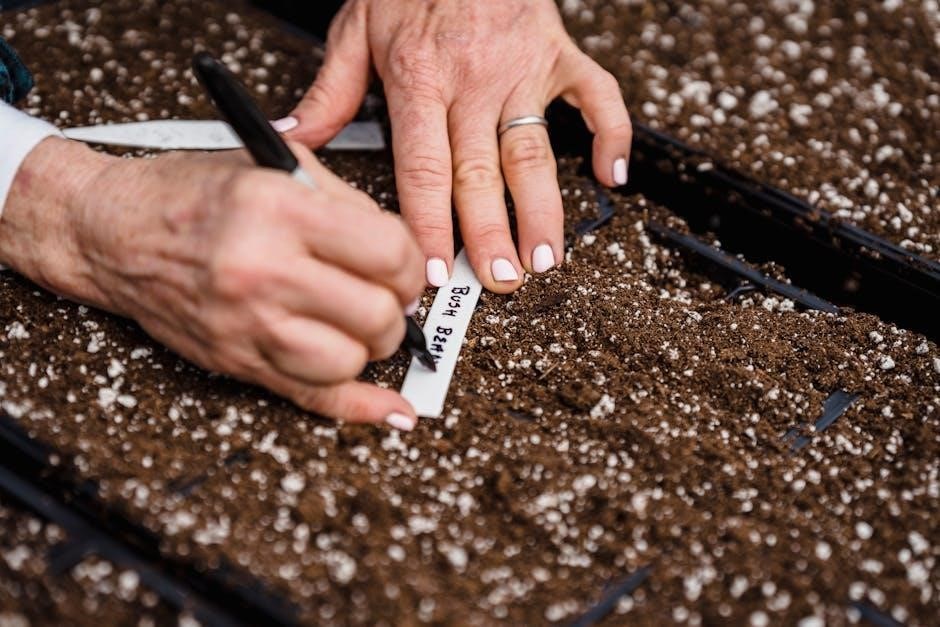Zone 9 offers a long growing season, ideal for year-round vegetable gardening. With minimal frost and warm temperatures, gardeners can enjoy planting a wide variety of crops throughout the year.
1.1 Understanding USDA Hardiness Zone 9
USDA Hardiness Zone 9 covers areas with average annual extreme temperatures between 20°F and 30°F (-7°C to -1°C). Divided into 9a and 9b, Zone 9b is slightly warmer than 9a. This zone enjoys a long growing season, typically from late February to early December, with minimal frost risk. Gardeners in Zone 9 benefit from the ability to grow vegetables year-round, including both cool- and warm-season crops. The warm climate allows for multiple harvests and a wide variety of plants, making it an ideal location for vegetable gardening with proper planning and care.

1.2 Climate Overview of Zone 9
Zone 9 experiences a Mediterranean climate with hot, dry summers and mild, wet winters. The growing season is long, allowing gardeners to plant vegetables from late February to early December. Summers are ideal for warm-season crops like tomatoes and peppers, while winters support cool-season crops such as broccoli and spinach. The average last frost date is around March 1st, and the first frost occurs near December 15th. This climate diversity makes Zone 9 perfect for year-round gardening, offering ample opportunities to grow a wide variety of vegetables with proper planning and care.
1.3 Benefits of Year-Round Gardening in Zone 9
Zone 9’s climate allows gardeners to enjoy year-round vegetable gardening, maximizing crop diversity and yield. With minimal frost, gardeners can plant cool-season crops in winter and warm-season crops in summer. This extended growing season ensures a constant harvest, providing fresh produce throughout the year. Additionally, year-round gardening in Zone 9 promotes sustainable living, reduces reliance on supermarkets, and enhances food security. The ability to grow a wide variety of vegetables, from tomatoes to spinach, makes Zone 9 an ideal location for gardeners seeking consistent and abundant harvests.
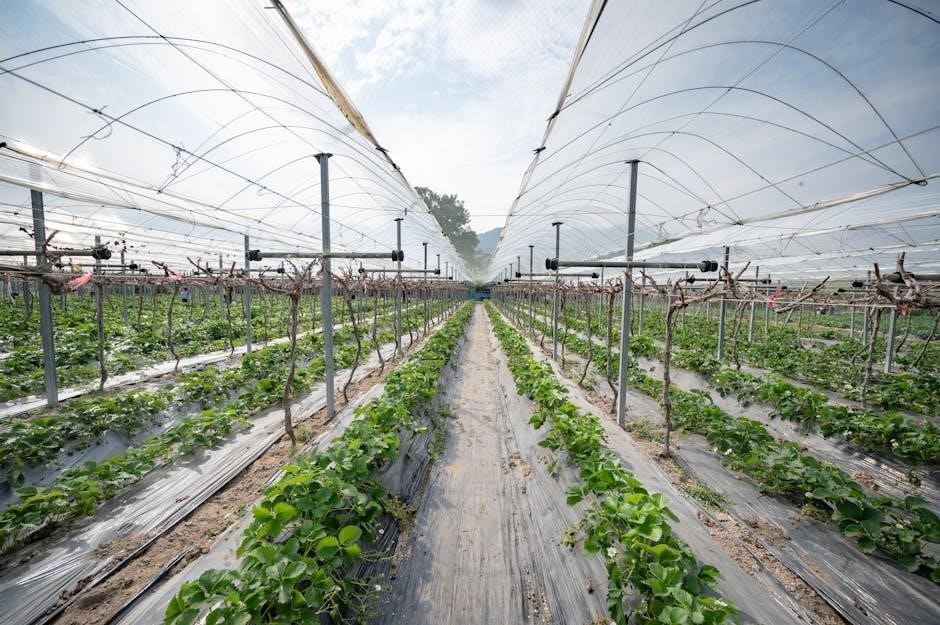
Month-by-Month Planting Guide for Zone 9
Zone 9’s extended growing season allows gardeners to plant a wide variety of vegetables year-round, with specific crops thriving in each month’s unique climate conditions.
2.1 January: Cool-Season Crops
In Zone 9, January is ideal for planting cool-season crops like broccoli, kale, and spinach, which thrive in cooler weather. Direct sow beets, carrots, and radishes, or transplant cabbage and cauliflower. Ensure soil is well-prepared with compost and maintain consistent moisture. These crops tolerate light frosts and mature quickly, making January a great time to establish a spring harvest. Avoid overwatering to prevent root rot, and provide partial shade for delicate greens. This period sets the foundation for a bountiful spring garden in Zone 9’s mild winter conditions.
2.2 February: Early Spring Planting
February marks the beginning of early spring planting in Zone 9. Gardeners can start sowing seeds for cool-season crops like peas, spinach, and lettuce directly into the soil. This month is also ideal for transplanting broccoli and cauliflower seedlings. As the weather begins to warm, ensure plants receive adequate sunlight and well-draining soil. Incorporate compost to enrich the soil and promote healthy growth; With mild temperatures, February is a transitional month where cool-season crops continue to thrive while preparing for the upcoming warm-season varieties. Proper spacing and consistent watering are crucial for optimal results during this period.
2.3 March: Transition to Warm-Season Crops
March signals the transition from cool-season to warm-season crops in Zone 9. Gardeners can begin planting tomatoes, peppers, and eggplants, either by starting seeds indoors or direct sowing. Zucchini, cucumbers, and squash also thrive when soil temperatures rise. Ensure soil is well-prepared with compost for optimal growth. As the weather warms, focus on proper spacing and sunlight exposure for these heat-loving plants. This month is crucial for setting up a successful summer harvest, so prioritize timely planting and adequate care for newly transplanted seedlings.
2;4 April: Planting Warm-Season Vegetables
April is prime time for planting warm-season vegetables in Zone 9. Tomatoes, peppers, and eggplants should be transplanted into well-prepared soil. Direct sow beans, corn, and squash for a bountiful summer harvest. Ensure adequate spacing and full sun exposure. Soil temperature should be above 60°F for optimal germination. Consider companion planting to deter pests and enhance growth. Regular watering and mulching are essential to retain moisture and suppress weeds. With warm weather setting in, monitor plants closely for signs of stress or pests to ensure a thriving garden throughout the season.
2.5 May: Summer Vegetables and Herbs
May is ideal for planting summer vegetables and herbs in Zone 9. Tomatoes, peppers, and squash thrive in the warm weather. Direct sow heat-tolerant varieties like zucchini, corn, and okra. Herbs such as basil, mint, and cilantro also excel in May’s climate. Ensure plants receive full sun and well-draining soil. Water deeply but avoid overwatering to prevent root issues. Mulch around plants to retain moisture and suppress weeds. Consider companion planting to enhance growth and deter pests. With temperatures rising, monitor soil moisture and provide shade for sensitive plants if necessary. This month sets the stage for a bountiful summer harvest.
2;6 June: Heat-Tolerant Varieties
June in Zone 9 is ideal for planting heat-tolerant vegetables and herbs. Tomatoes, peppers, eggplants, and okra thrive in the high temperatures. Direct sow zucchini, yellow squash, and Southern peas for a summer harvest. Herbs like basil and dill also excel in June’s warm climate. Ensure plants receive full sun and well-draining soil. Water deeply but avoid overwatering to prevent root rot. Mulch around plants to retain moisture and suppress weeds. Consider using row covers to protect from intense sun. This month is perfect for maximizing summer yields with resilient, heat-loving crops that tolerate Zone 9’s warm conditions.
2.7 July: Sowing for Fall Harvest
In Zone 9, July is the time to sow seeds for a bountiful fall harvest. Plant cool-season vegetables like broccoli, Brussels sprouts, cabbage, kale, and spinach. Herbs such as cilantro and dill can be direct-sown. Start seedlings indoors 4-6 weeks before the first frost date to ensure they have enough time to mature. Proper planning in July ensures a successful and productive fall garden in Zone 9.
2.8 August: Planting Cool-Season Crops
August in Zone 9 is ideal for planting cool-season crops that thrive in cooler temperatures. Direct sow vegetables like beets, carrots, Swiss chard, kohlrabi, lettuce, mustard greens, onion sets, parsnips, peas, radishes, spinach, and turnips. These crops prefer the warm soil of late summer but will mature as the weather cools. Additionally, start seedlings indoors for broccoli, Brussels sprouts, and cabbage, transplanting them in early fall. Proper planning in August ensures a robust harvest as the season transitions into cooler months.
2.9 September: Fall Gardening
September marks the start of fall gardening in Zone 9, offering ideal conditions for cool-season crops. Plant vegetables like broccoli, Brussels sprouts, and kale for a winter harvest. Root vegetables such as carrots, beets, and radishes thrive in cooler soil. Direct sow spinach, lettuce, and arugula for fresh greens. Consider transplanting seedlings of cabbage and cauliflower started earlier. Ensure soil is well-prepared with compost for optimal growth. Companion planting with herbs like cilantro or dill can enhance yields. With proper planning, September plantings will provide a bountiful fall harvest in Zone 9’s mild climate.
2.10 October: Preparing for Winter
October in Zone 9 is ideal for transitioning to winter crops. Plant cool-season vegetables like spinach, lettuce, and root vegetables such as carrots and beets. Add compost to the soil to enrich it for winter growth. Mulch around plants to retain moisture and protect against cooler nights. Protect sensitive plants from early frosts using covers or row covers. Clean up garden beds to remove debris and prevent pests. Plan and prepare soil for the next growing season, ensuring it’s ready for early spring planting. October is a key month for setting up a successful winter garden in Zone 9.
2.11 November: Winter Vegetables
November is a great time to plant winter vegetables in Zone 9. Cool-season crops like broccoli, kale, and spinach thrive in the cooler weather. Root vegetables such as carrots, radishes, and turnips also do well. Plant lettuce, arugula, and mustard greens for fresh salads. Consider companion planting to deter pests and improve growth. Soil preparation is key—add compost to enrich the earth. Protect plants from early frosts with row covers or mulch. November’s mild temperatures make it an ideal month to establish a robust winter garden, ensuring a bountiful harvest during the colder months.
2.12 December: Final Plantings for the Year
December marks the final planting opportunities in Zone 9 before the year ends. Focus on cool-season crops like spinach, kale, and lettuce, which thrive in cooler weather. Root vegetables such as carrots, radishes, and turnips can also be planted. Consider succession planting to extend harvests into early spring. Protect plants from frost with row covers or mulch. December’s mild temperatures allow for a last round of planting, ensuring fresh produce well into the winter months. This period is ideal for hardy varieties that tolerate light frosts, making it a great time to round out your winter garden.

Best Vegetables for Zone 9 Gardens
Zone 9 gardens thrive with tomatoes, peppers, squash, broccoli, Brussels sprouts, and herbs like basil and cilantro. These crops excel in the region’s warm, sunny conditions.
3.1 Cool-Season Vegetables
Cool-season vegetables thrive in Zone 9’s mild winters and early springs. Ideal crops include broccoli, Brussels sprouts, spinach, and lettuce. Plant these in late summer for a fall harvest or early spring for a summer yield. Root vegetables like beets, carrots, and radishes also excel. These crops prefer temperatures below 85°F and can tolerate light frosts. Start seeds indoors 4-6 weeks before the last frost date for an early start. Companion planting with herbs like cilantro and dill can enhance growth and deter pests. Proper spacing and consistent moisture ensure healthy development in Zone 9’s climate.
3.2 Warm-Season Vegetables
Warm-season vegetables flourish in Zone 9’s hot summers. Tomatoes, peppers, eggplants, and squash are ideal choices. Plant these after the last frost in late spring for a summer harvest or in late summer for a fall yield. Cucumbers and zucchini thrive in Zone 9’s climate. These crops require full sun, well-drained soil, and consistent watering. Companion planting with herbs like basil and oregano enhances flavor and deters pests. Proper spacing is crucial to prevent overcrowding and promote air circulation, ensuring healthy growth and abundant yields throughout the warmest months.
3.3 Herbs for Zone 9
Zone 9’s warm climate is perfect for growing a variety of herbs year-round. Popular choices include basil, oregano, rosemary, thyme, mint, and cilantro. Most herbs thrive in well-drained soil and full sun, making Zone 9 ideal for their growth. Plant herbs like basil and cilantro in cooler months for optimal flavor, while rosemary and thyme can be grown year-round. Companion planting with vegetables enhances growth and flavor. Regular pruning encourages bushy growth and prevents the herbs from flowering. With proper care, Zone 9 gardeners can enjoy fresh, fragrant herbs throughout the year, adding zest to countless dishes.
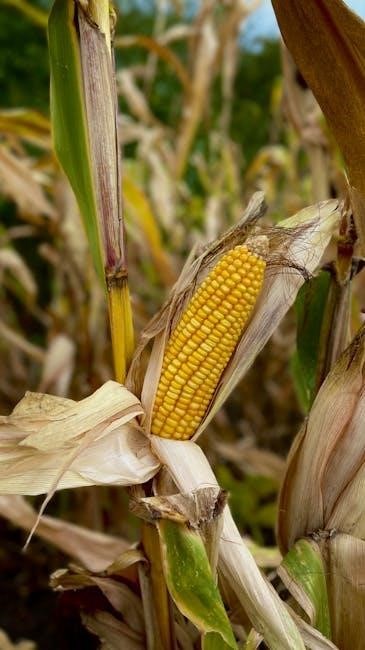
Garden Preparation and Planning
Proper garden preparation ensures a thriving Zone 9 vegetable garden. Focus on soil health, layout, and spacing to maximize growth and efficiency throughout the year.
4.1 Soil Preparation for Vegetable Gardening
Soil preparation is crucial for a successful Zone 9 vegetable garden. Test your soil to determine pH and nutrient levels. Most vegetables thrive in slightly acidic to neutral soil (pH 6.0–7.0). Add compost or well-rotted manure to improve soil structure and fertility. For sandy soils, incorporate organic matter to retain moisture. In clay soils, mix in sand or perlite to enhance drainage. Till the soil to a depth of 8-10 inches to loosen it and promote root growth. Ensure the area is clear of debris and weeds before planting.
4.2 Layout and Spacing
Proper layout and spacing are essential for a thriving Zone 9 vegetable garden, ensuring optimal growth and reducing competition for resources. Arrange plants according to their mature size, with taller varieties placed on the north side to avoid shading smaller ones. Maintain spacing recommendations on seed packets to prevent overcrowding, which can lead to disease and pest issues. Consider companion planting to maximize space and deter pests—e.g., planting marigolds with tomatoes or basil with peppers. Vertical gardening techniques, like trellises for peas or beans, can also save space. Proper planning enhances air circulation and reduces weed growth, ensuring a healthy and productive garden.
4.3 Companion Planting
Companion planting is a valuable technique in Zone 9 gardens, enhancing growth and reducing pests. Pairing vegetables with complementary herbs and flowers improves soil health and deters unwanted insects. For example, basil repels aphids when planted near tomatoes, while marigolds discourage nematodes. Nasturtiums and calendula attract beneficial insects, protecting crops like cucumbers and squash. Planting beans with corn and squash in the “Three Sisters” method promotes mutual support. Some combinations, like onions and beans, should be avoided due to negative interactions. Strategic companion planting optimizes space, boosts yields, and creates a balanced ecosystem in your garden.
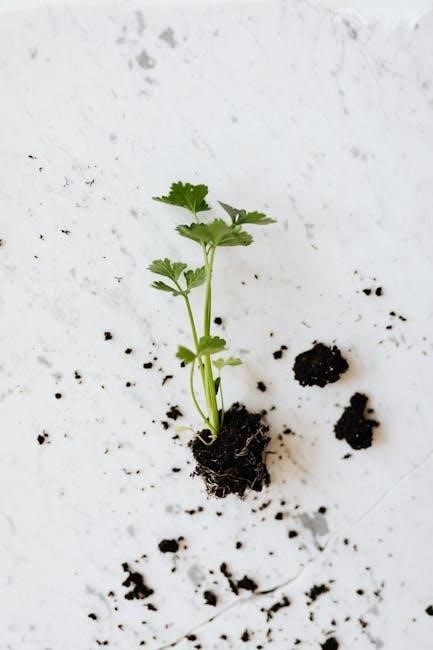
Starting Seeds Indoors
Starting seeds indoors in Zone 9 allows gardeners to get a head start on the growing season, ensuring healthy seedlings before transplanting outside after the last frost date.
5.1 When to Start Seeds Indoors
In Zone 9, start seeds indoors 4-6 weeks before the last frost date, typically late January to early February. This allows seedlings to mature before being transplanted outside in late spring, maximizing the growing season. Cool-season crops like broccoli and kale can be started earlier, while warm-season crops like tomatoes and peppers should wait until February; Ensure seedlings have adequate light and proper care before transitioning outdoors. Proper timing is crucial for optimal growth and productivity in Zone 9’s climate.
5.2 How to Start Seeds Indoors
Starting seeds indoors in Zone 9 requires careful preparation. Use seed trays or small pots with a well-draining potting mix. Sow seeds at the depth recommended on the seed package. Water gently and maintain consistent moisture. Provide warmth, typically 70-80°F, until germination. Once seedlings emerge, offer bright light, such as grow lights, for 12-14 hours daily. Avoid overwatering to prevent damping off. Harden off seedlings before transplanting outdoors, gradually exposing them to sunlight and cooler temperatures over 7-10 days. Proper care ensures healthy, robust seedlings ready for the garden.
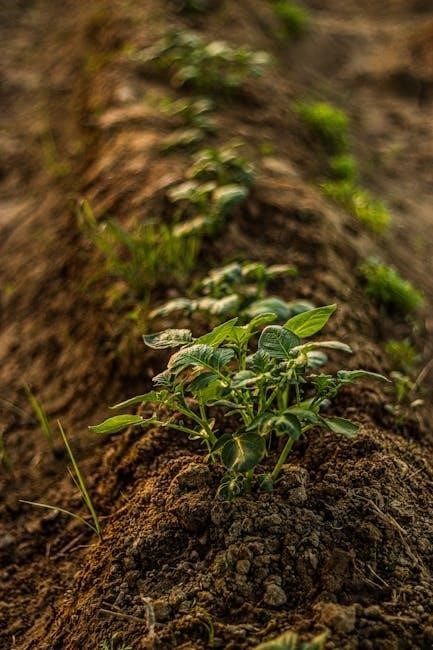
Transplanting Seedlings
Transplanting seedlings in Zone 9 requires careful timing and handling. Move seedlings after the last frost, ensuring they are hardened off. Water thoroughly and provide shade initially to prevent shock.
6.1 Hardening Off Seedlings
Hardening off seedlings is essential before transplanting them outdoors in Zone 9. Start by moving seedlings to a shaded area outdoors for 1-2 hours daily, gradually increasing exposure to sunlight and wind over 7-10 days. Avoid direct sun and extreme temperatures during this process. Water seedlings thoroughly each day to prevent stress. Once acclimated, transplant them in the late afternoon or on a cloudy day to minimize shock. Proper hardening ensures seedlings adapt smoothly to outdoor conditions, promoting healthy growth and higher survival rates in Zone 9’s climate.
6.2 Best Time to Transplant
The best time to transplant seedlings in Zone 9 is during the cooler parts of the day, such as late afternoon or early morning, to minimize stress. Avoid transplanting during intense heat or wind. For warm-season crops like tomatoes and peppers, wait until the soil has warmed and the risk of frost has passed, typically after late March. Cool-season crops, such as broccoli and kale, can be transplanted in early spring or late summer for a fall harvest. Proper timing ensures seedlings adapt well to outdoor conditions and thrive in Zone 9’s climate.
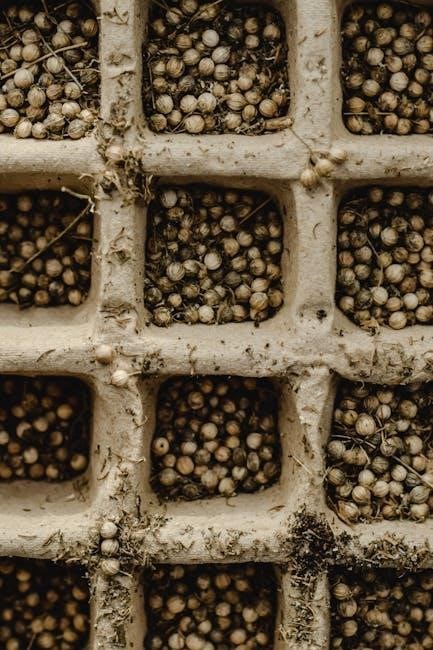
Common Challenges in Zone 9 Gardening
Zone 9 gardeners face challenges like pests, diseases, and water management due to the warm climate. Proper techniques and timely interventions are essential for a thriving garden.
7.1 Managing Pests

Pests like aphids, whiteflies, and hornworms thrive in Zone 9’s warm climate. Use natural predators, neem oil, and row covers to control infestations. Regularly inspect plants and maintain garden cleanliness to prevent pest buildup. Encourage beneficial insects and practice crop rotation to break pest life cycles. Hand-picking and targeted insecticides can also be effective. Early detection is key to minimizing damage and ensuring a healthy harvest. Implementing integrated pest management strategies will help protect your vegetables from common Zone 9 pests throughout the growing season. Consistent monitoring and proactive measures are essential for a pest-free garden.
7.2 Dealing with Diseases
Zone 9’s warm, humid climate can foster fungal and bacterial diseases in vegetables. Regularly inspect plants for signs of infection, such as yellowing leaves or black spots. Practice crop rotation to reduce soil-borne pathogens and remove infected plants promptly. Improve air circulation by spacing plants appropriately and avoid overhead watering, which can spread disease. Treat infections with organic or chemical fungicides as needed. Use disease-resistant varieties to minimize risks. Maintain healthy soil and provide adequate nutrients to strengthen plant immunity. Preventative measures, like proper watering and sanitation, are key to managing diseases effectively in Zone 9 gardens.
7.3 Water Management
Effective water management is crucial in Zone 9’s hot, dry climate. Vegetables need consistent moisture, but overwatering can lead to root rot and other issues. Use drip irrigation or soaker hoses to deliver water directly to roots, reducing evaporation. Mulch around plants to retain soil moisture and suppress weeds. Avoid overhead watering, which can promote fungal diseases. Check soil moisture by digging a small hole nearby. Water deeply but infrequently to encourage deep root growth. Adjust watering schedules seasonally, increasing during summer heat and reducing in cooler months. Proper watering practices ensure healthy, thriving plants in Zone 9 gardens.
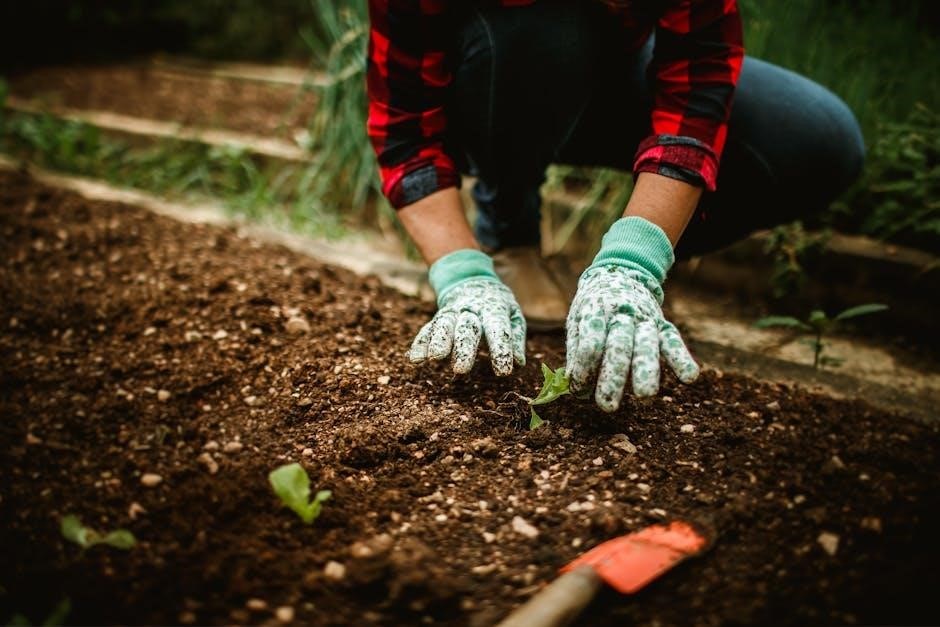
Year-Round Gardening Tips
Zone 9’s long growing season allows for continuous gardening. Use planting charts for optimal timing, practice crop rotation, and extend the season with row covers or cold frames.
8.1 Extending the Growing Season
To maximize your harvest, consider extending the growing season in Zone 9. Start seeds indoors 4-6 weeks before the last frost date and transplant after weather stabilizes. Use row covers or cold frames to protect cool-season crops from heat or frost. Succession planting ensures a continuous supply of fresh produce. Additionally, plant varieties with shorter maturation periods to fit in multiple harvests. Shade cloth can shield plants from intense summer sun, while drip irrigation maintains consistent soil moisture. These techniques allow gardeners to enjoy a bountiful harvest year-round in Zone 9’s favorable climate.
8.2 Crop Rotation
Crop rotation is essential for maintaining soil health and preventing pests and diseases in Zone 9 gardens. Rotate plants from different families to avoid depleting specific nutrients and to break pest and disease cycles. For example, follow leafy greens with root vegetables or tomatoes with beans. This practice promotes balanced soil fertility and reduces the need for fertilizers. Incorporate green manures like clover or rye to enrich the soil further. By planning rotations carefully, gardeners can maximize yields, improve soil structure, and create a sustainable growing system tailored to Zone 9’s unique conditions.
Zone 9’s long growing season offers gardeners a unique opportunity for year-round vegetable cultivation. With proper planning and care, you can enjoy a bountiful harvest every season.
9.1 Final Tips for Success
For a thriving Zone 9 garden, maintain consistent water management, especially during heatwaves. Rotate crops annually to replenish soil nutrients and prevent pests. Start seeds indoors before the last frost date to maximize the growing season. Pair vegetables strategically using companion planting to deter pests and enhance growth. Keep a gardening journal to track progress and adapt strategies yearly. Utilize online resources like planting charts and calendars for precise timing. By following these tips, you’ll optimize yields and enjoy a vibrant, productive garden all year round.
9.2 Resources for Zone 9 Gardeners
Zone 9 gardeners can utilize resources like the Old Farmer’s Almanac planting calendar for precise planting dates. The Kellogg Garden Zone Planting Charts provide detailed sowing, planting, and harvesting timelines; Local cooperative extensions and gardening communities offer tailored advice for specific regions within Zone 9. Online forums and gardening groups share experiences and tips for managing pests, diseases, and water efficiently. These resources empower gardeners to maximize their yields and adapt to local conditions effectively, ensuring a successful and productive garden year-round.

